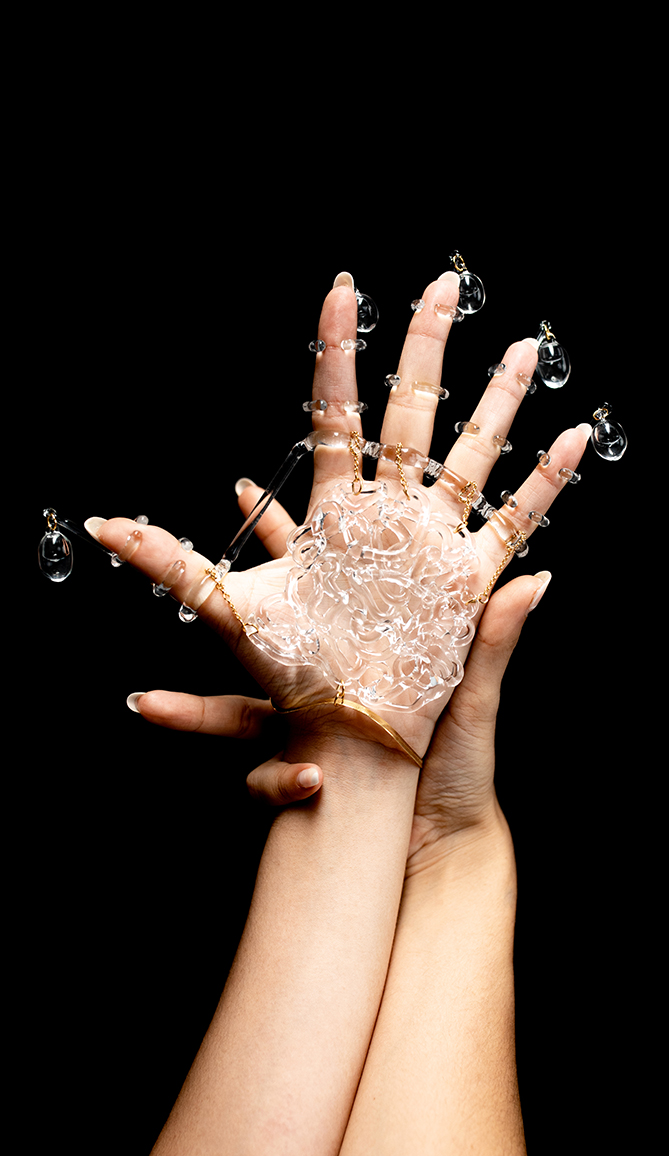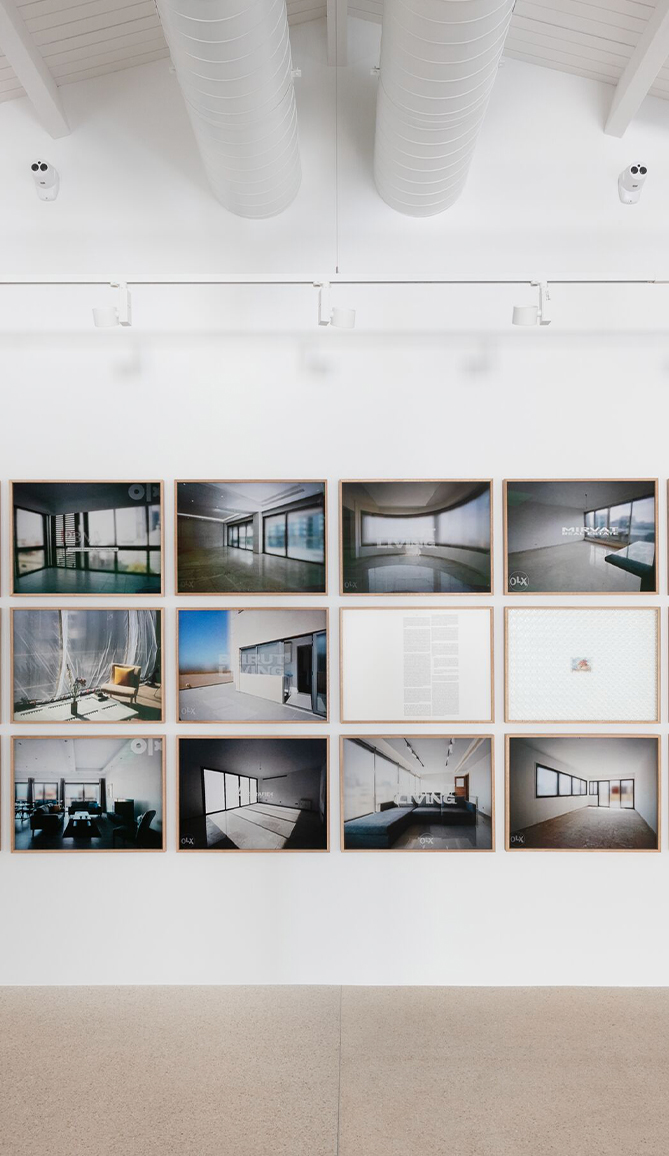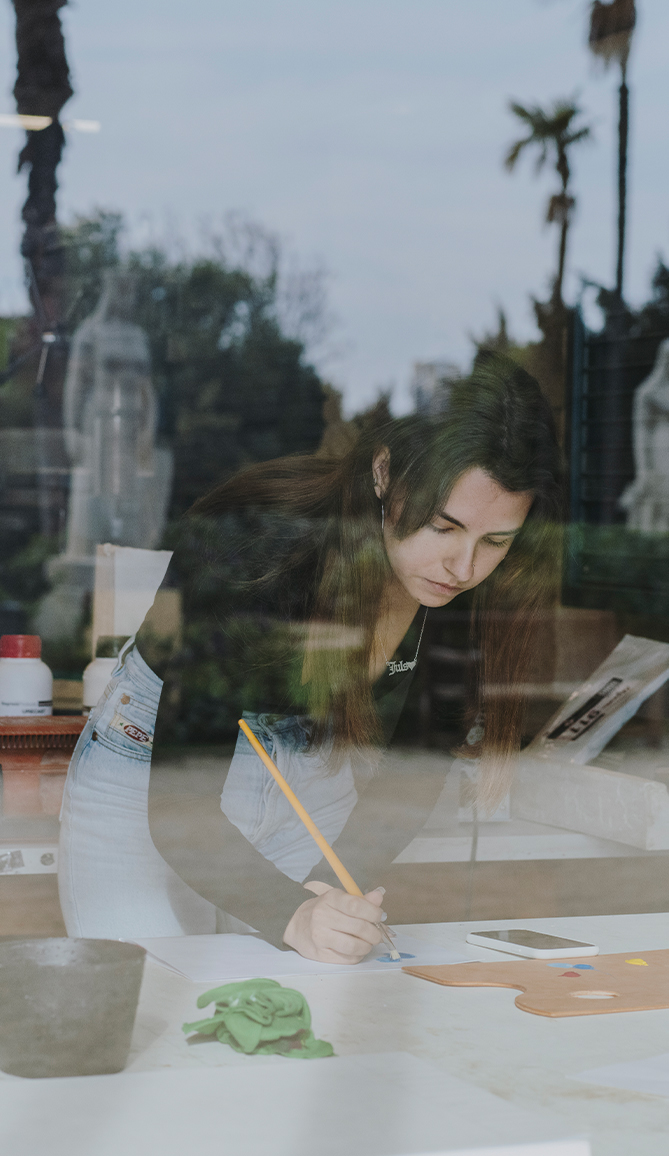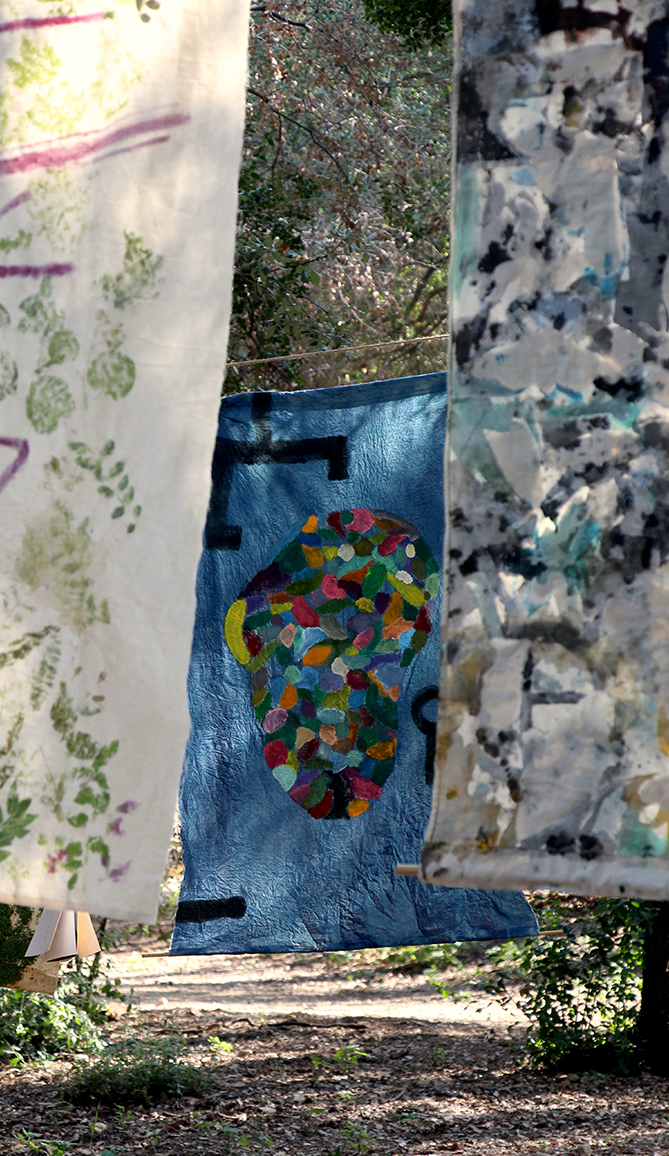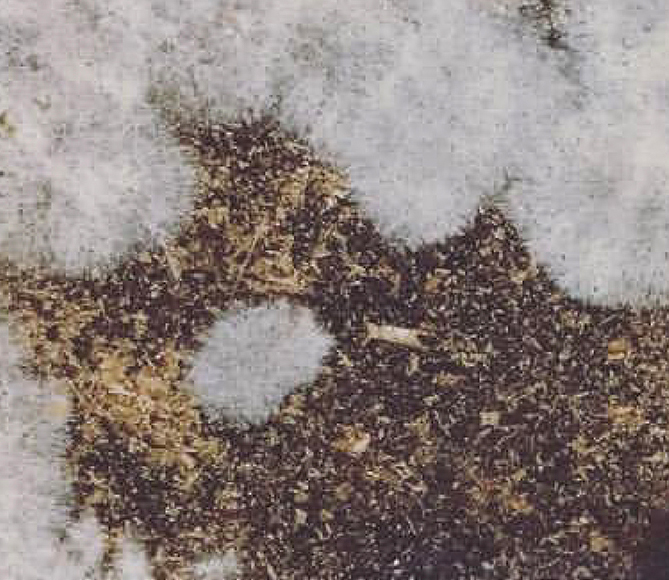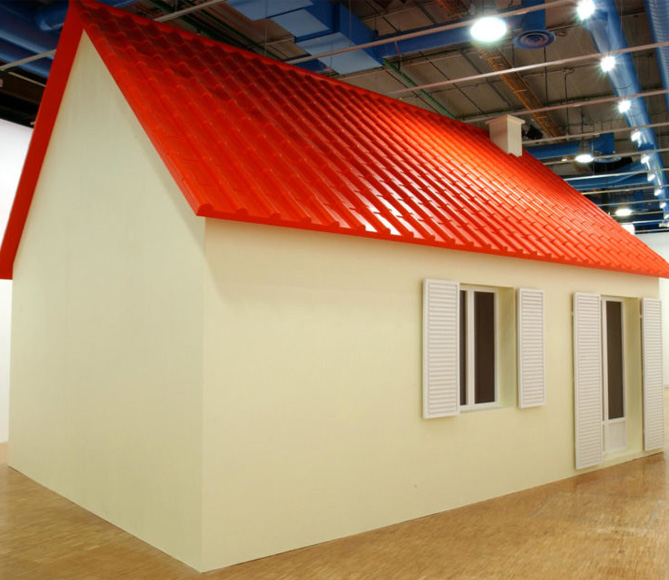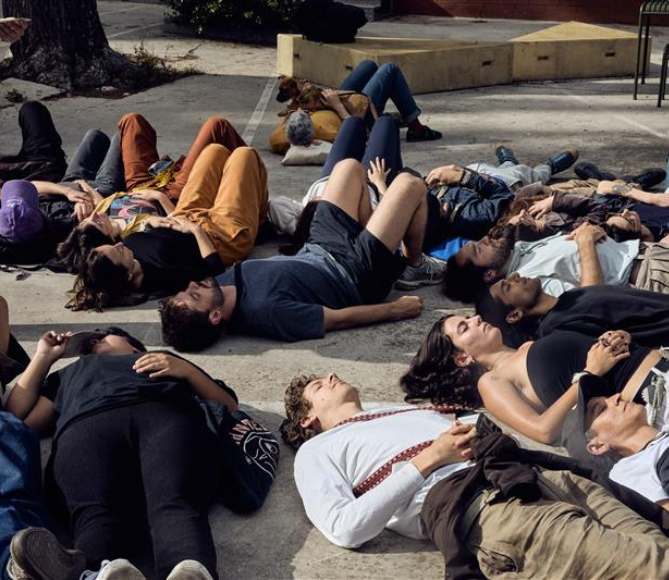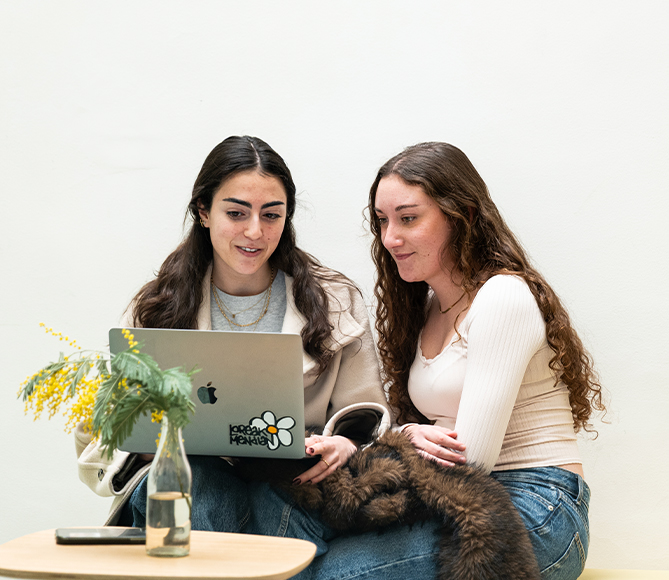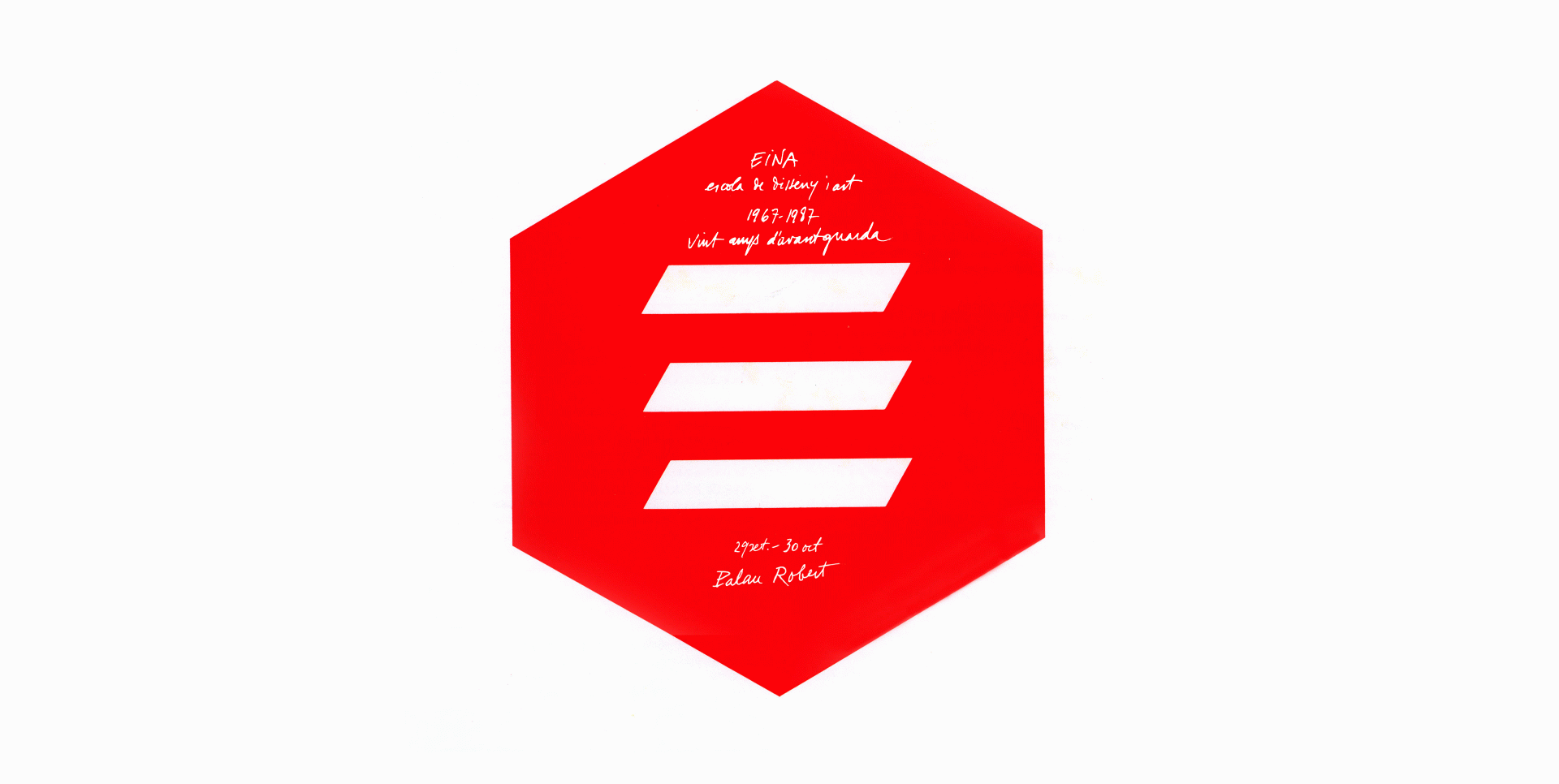EINA celebrated its twentieth anniversary at the Palau Robert in Barcelona with the exhibition EINA 20 years at the avant-garde: 1967-1987, sponsored by the Government of Catalonia's Department of Culture.
Beth Galí and Xavier Olivé were in charge of the exhibition and assembling it at the Palau Robert along with participation from Josep Aregall, Màrius Quintana, and Anna de Tort, which was the winner of the FAD award for ephemeral interventions.

A large totem pole at the entrance connected the ground floor and the first floor of the Palau Robert, marking the beginning of a labyrinth built with wooden formwork that ran through the different rooms in the building.
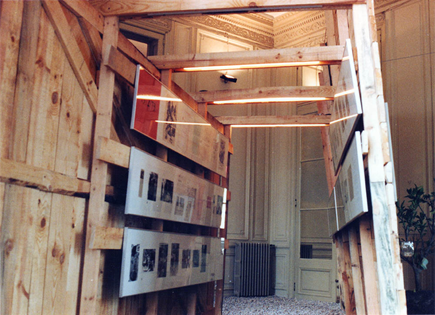
A chronology was posted along the corridors of the labyrinth's walls, recounting EINA's story over the years through texts, posters, and photographs.
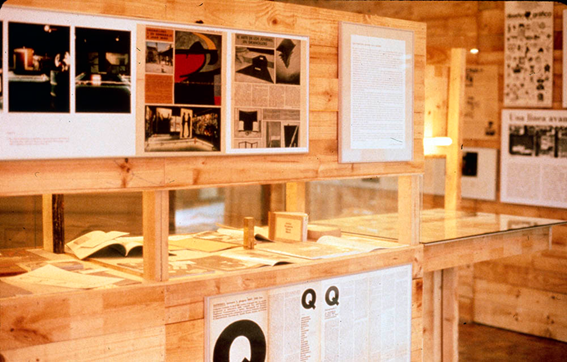
The exhibition gave attendees the chance to relive the most memorable actions, works, and exhibitions from EINA's first twenty years of existence. Works such as Experimental environment (1969), Transformation of the garden at a 1:1 scale (1972), Super collage (1973), and Realistic still life (1984), among many others, were given new life once again.
One of the most significant aspects is that the celebration featured an open exhibition that was tweaked day by day until the closing event through participatory workshops and live performances. The following lists just some of the examples.
Experimental environment

A reproduction of the first experimental environment by students in academic year 67-68 through a piece by the designer Carles Riart. In the original experience, the students in the Colour course taught by Albert Ràfols produced an installation that was realised collectively in which each student was in charge of painting one side of a cube based on studies and work conducted beforehand on colour and composition theory, volumetric modules, textures, music and sound, light changes, and slide projections that contributed to the two-day transformation of the classroom. The musical background for the piece was the album More by Pink Floyd, recorded as the soundtrack for Barbet Schroeder's film of the same name.
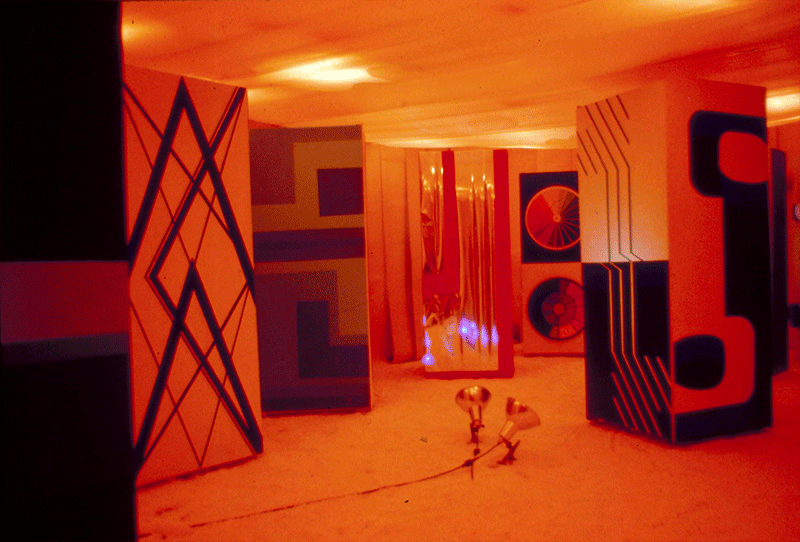
Karl Marx
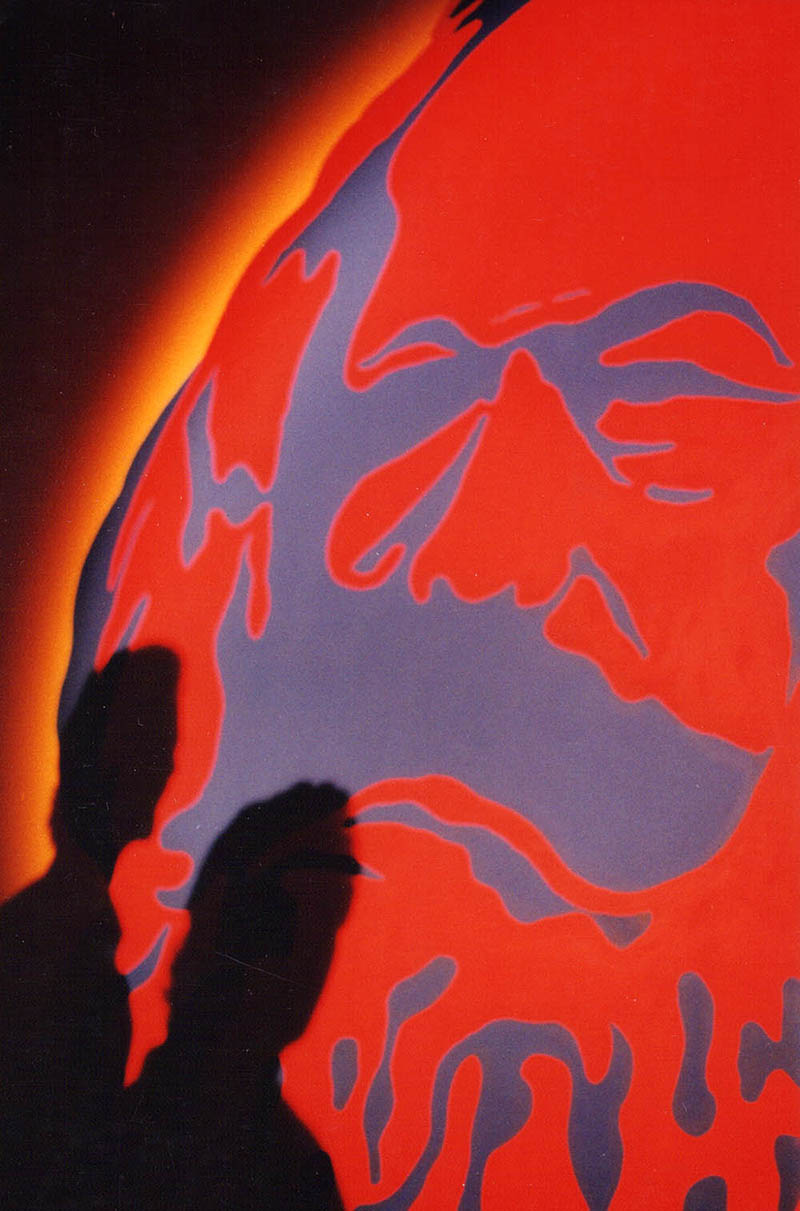
Reinterpretation of the work Karl Marx by l'Equip 2 formed by EINA students Albert Romero and Antoni Raja, which emerged as part of the Estampa Popular movement. Some of these groups include: l'Equip A, formed by Ramon Herreros, Josep-Luís Jubany, Jordi Morera, and Alexandre Tornabell, characterised by the use of different media and languages, both from the field of design and from mass media, such as contemporary art; or Taller Tres, formed by Josep Mañà, Alexandre Ferrer, and Francesc Casademont, who aimed their activism towards the production of accessible objects beyond the range of commercial channels and, above all, in actions with an educational purpose at youth and school associations, including in the area of training designers. The work, with a clear political intention, is formally based on Pop Art and uses stencilling as a technique.
Arte Povera and Land Art
Sílvia Gubern, Àngel Jové, and Antoni Llena interpret the works made in the gardens at EINA and El Maduixer in a space that is transformed into a lemon tree that evokes a garden and photographs of the group that could be accessed by stepping on pebbles.
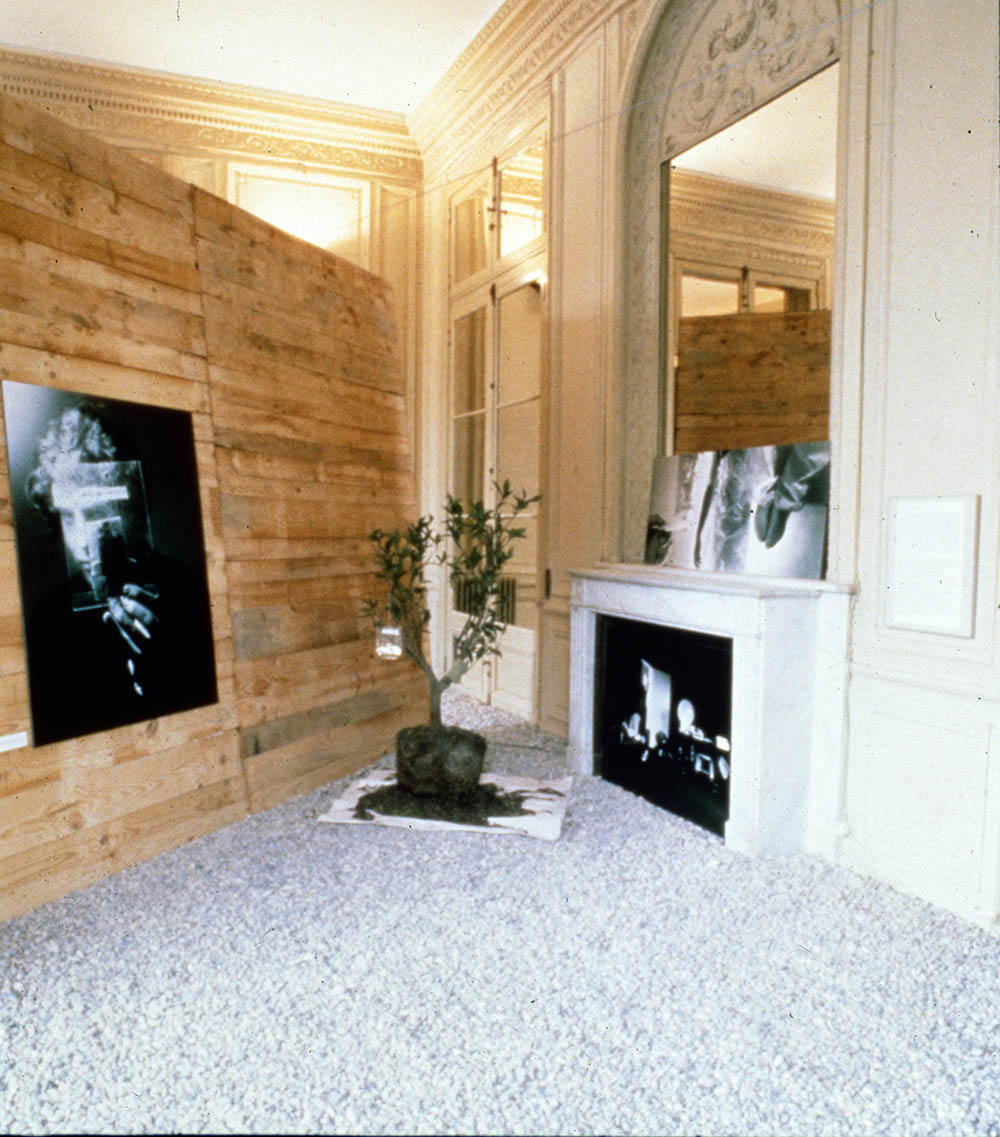
Hypnotic painting and kitsch
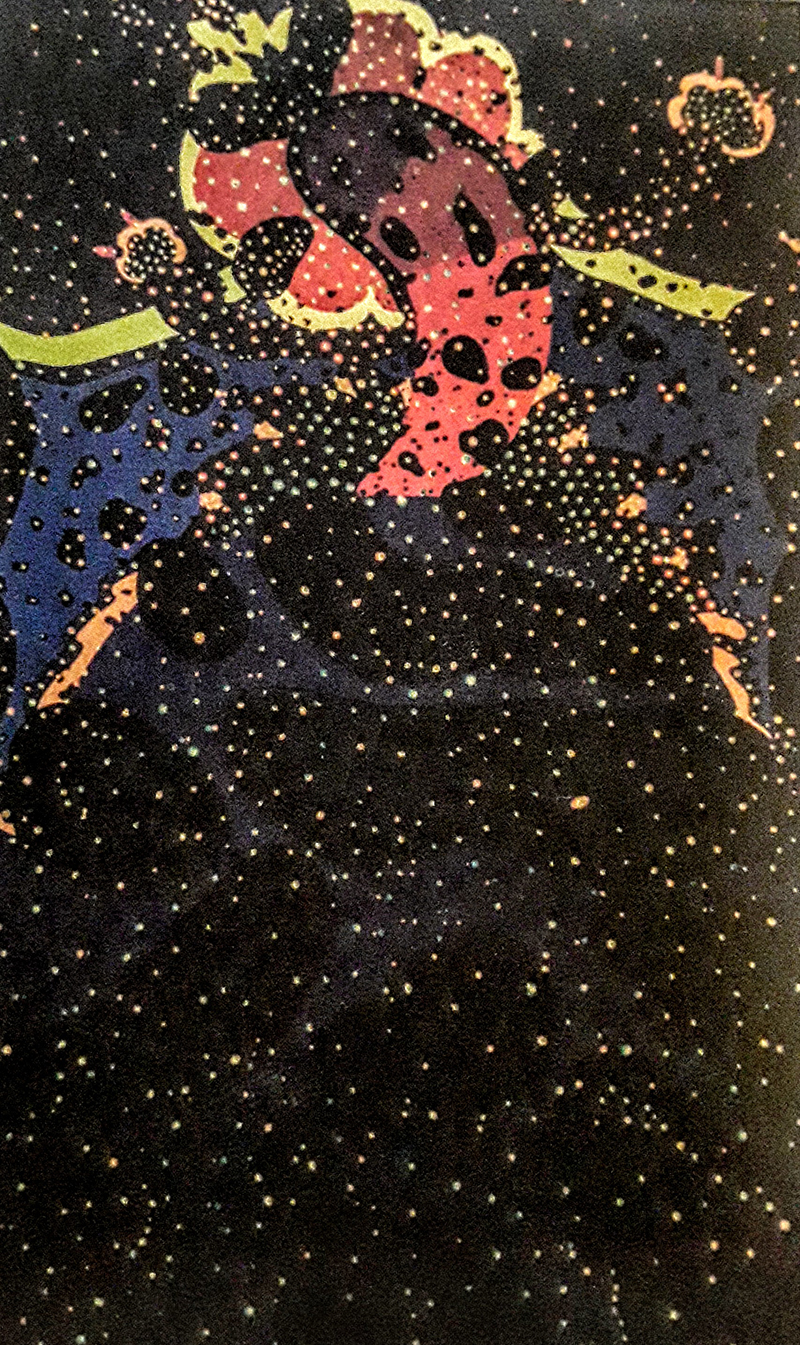
Jordi Galí and Jordi Galí Jr. presented a futuristic living room constructed with Formica – a little-known material at the time – that evoked what was presented at the Hogar-Hotel fair. The space was white and illuminated with a black light, creating a hypnotic effect. On the wall, works by Albert Porta (Zush, later known as Evru) painted with phosphorescent paint could be found, which had been presented earlier at an exposition in the Galeria René Metràs in Barcelona in 1969. The entire floor was covered in cushions made of imitation panther fur.
The space is also an homage to Gillo Dorfles and in memory of the colloquium at EINA in which the Italian philosopher participated to talk about his books Simbolo, comunicazione, consumo and Nuovi riti, nuovi miti, a space was recreated by Jordi Galí and his son Jordi Galí featuring hypnotic paintings by Zush illuminated with a black light.
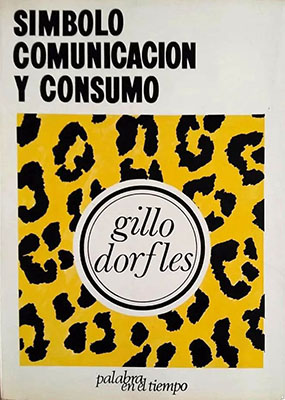
The 70’s living room
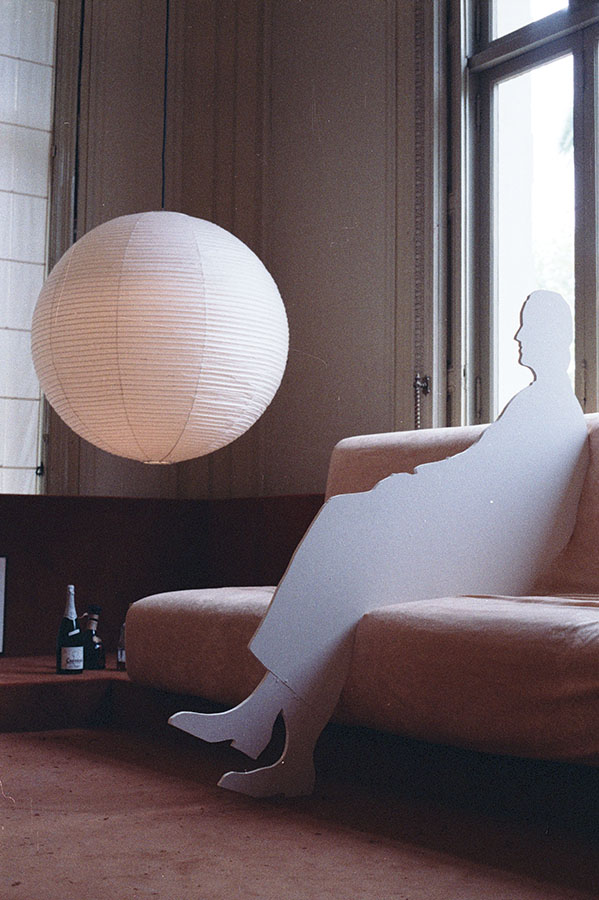
As a tribute to Federico Correa, Josep Alemany recreated an uneven room lined with shelves. The unfurnished space was completely covered by carpet, and the floor was full of pillows for sitting on and relaxing.
Transformation of the garden at a 1:1 scale
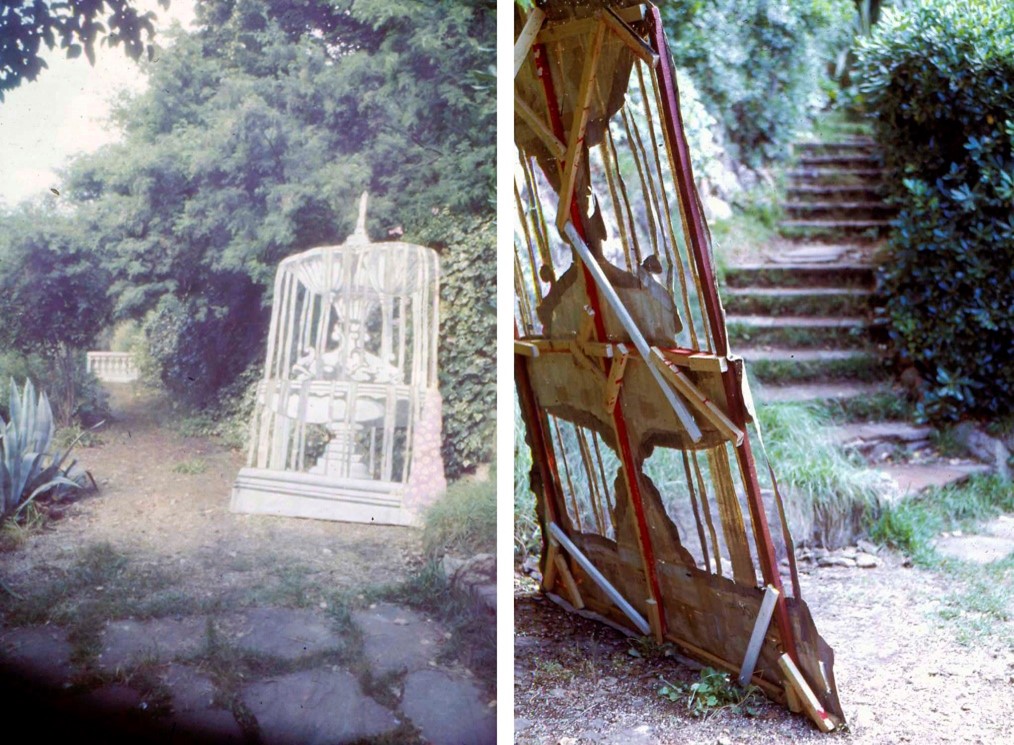
Looking through the balcony of the living room, attendees could see a reinterpretation of the performance created by Maria Girona in 1972 in the garden of the Casa Manuel Dolcet with hand-painted theatre sets depicting plants, trees, fountains, and balustrades that blended into nature.
Related post: El Jardí i EINA
Six memories, plus still lifes
On the occasion of the Calendars exposition (1972) held in an exhibition hall at the Caixa in Barcelona, Carlos Pazos presented the work 6 memories formed by various objects such as a bar towel, a calendar from the year 1973, a card with an image of a small plastic television, a flyer for the film La mujer marcada, a post card from Lloret de Mar, and a card with images of a pin-up. In February 1973, the exposition 6 memories + still lifes was presented at EINA, in which the artist manipulated images typical of pin-ups photographed for pocket calendars at the time. In 1987, recalling the Carlos Pazos montage exhibited at EINA in 1973, the light column Bibelot Boreal, which reproduced the abovementioned images on its screen, was presented alongside other design objects in the space dedicated to industrial design.
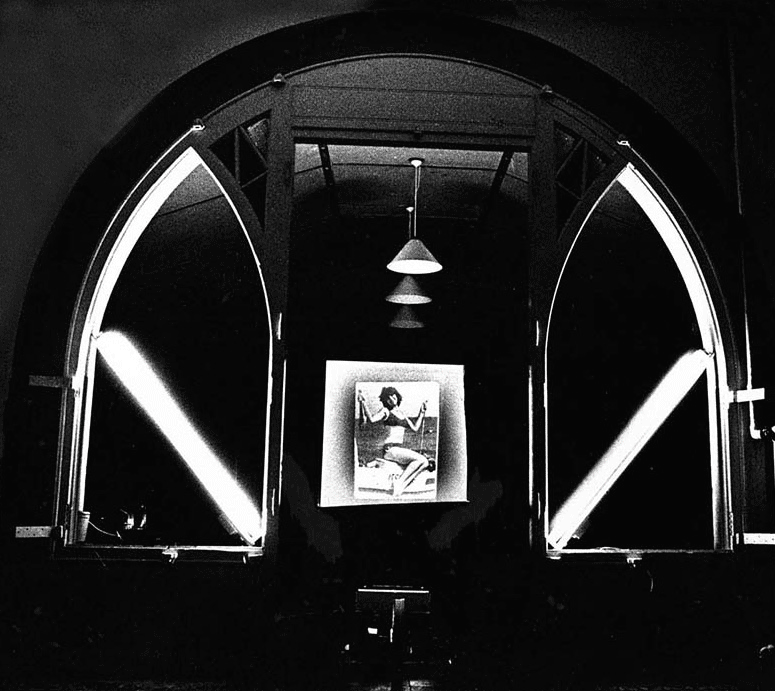
Tactile Space
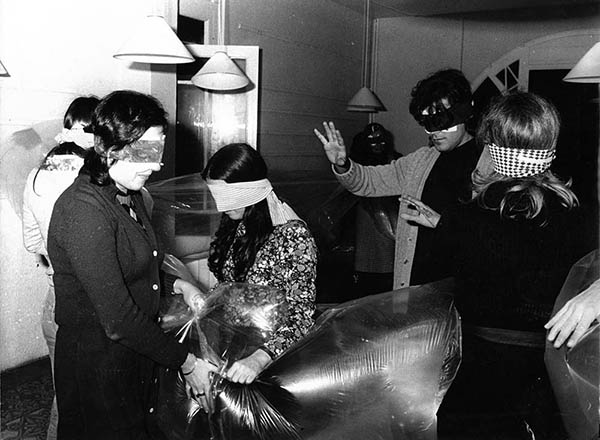
This space by Lluís Utrilla was dedicated to recalling experiences involving the interest in awakening the senses, conceptual art, and body art promoted at EINA.
Sound space
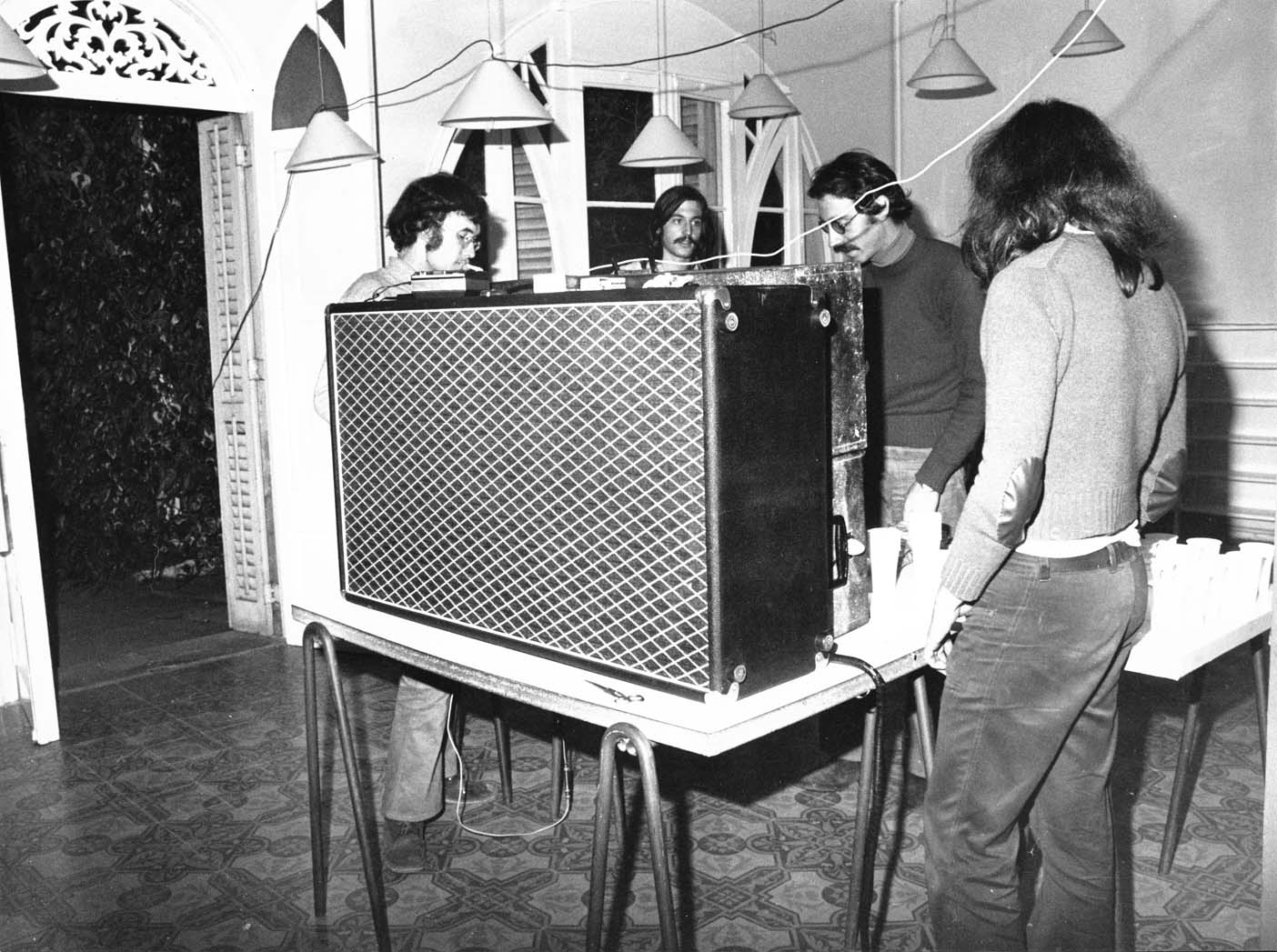
This space brought to mind another conceptual experience carried out by the EINA Communications Group (Xavier Bulbena, Irene Carbonell, Alexandre Ferrer, Ramón Herreros, Ascen Muñoz, Xavier Olivé, Enrique Sales, America Sanchez, Marga Sánchez Diezma, Nuria Vidal, Fernando García Sevilla y Carlos Pazos) called Firulete, in which microphones were installed at the entrance to the school and the sounds from them could be heard simultaneously in one of the classrooms which acted as a sounding board.
Related post to the EINA chronology: Firulete
Postal delivery
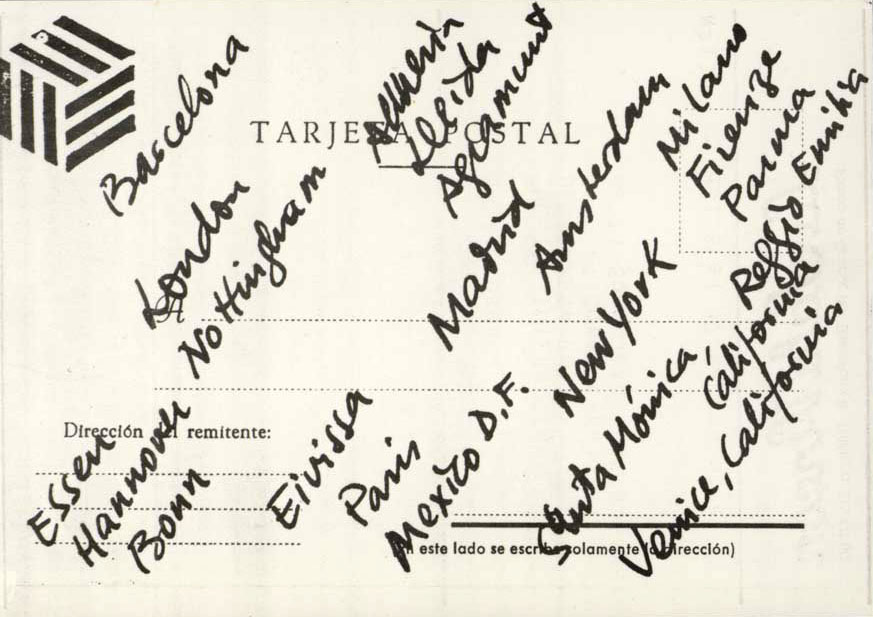
Within the framework of the International Telecommunication Convention of 1973, EINA held the 1st International Postal Delivery Exhibition, an attempt to speculate through distance communication enabling the exchange of art works or pieces whose origins could be found in different art currents through the mail. This mail art exhibition was showcased at EINA in 1972 and at the Sala Vinçon a year later on the occasion of the International Telecommunication Convention of 1973. International artists such as Lawrence Weiner, Ettore Sottsass, Joan Brossa, Josefina Miralles, John Baldessari, Bruce Gildem, Owe Pellsjö, Eugenio Miccini, and Charles Dillon participated, among others.
Super Collage
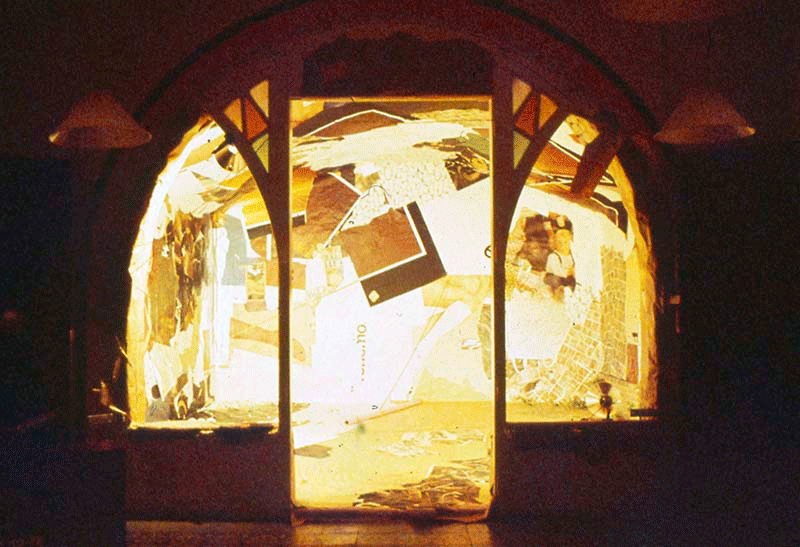
A collective experience by Yamandú Canosa, Mana Girona, Maria Helguera, Albert Ràfols-Casamada, Esther Rovira, Mario Albareda, Oriol Vilardell, and Neus Buira that made it possible to relive the experience carried out as part of the Colour Workshop taught by Albert Ràfols. It consisted of establishing a dialogue between the architectural space, the interior volume of the classroom, and the chromatic and formal elements that were incorporated into the walls, ceiling, and floor with the aim of understanding how these elements modify the notion of space through their interrelation.
The culinary relevance
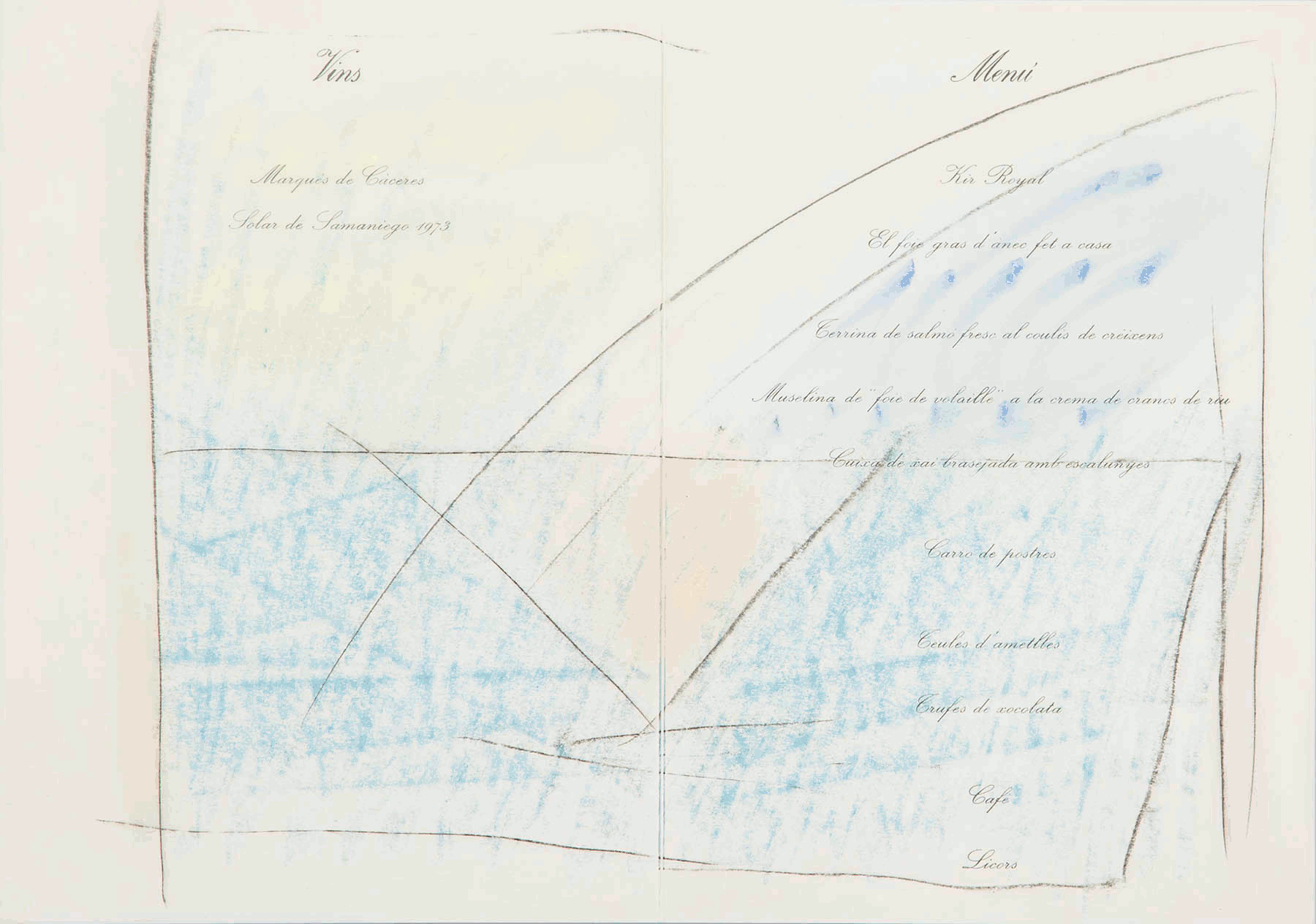
A standing table frames the hand-drawn menus by Sergi Aguilar, Francesc Artigau, Maria Girona, Xavier Olivé, Albert Ràfols-Casamada, and Francesc Todó that these artists created for the Taste and Style, an exchange of sensations course (1981). Rediscovering these works brings to mind earlier experiences such as the Taste in the kitchen course (1978) taught by Miquel Espinet, Joan Enric Lahosa, Xavier Olivé, and Llorens Torrado in addition to stressing the point that EINA has always considered cuisine and gastronomy as cultural relevant.
Related post: EINA and the culinary relevance.
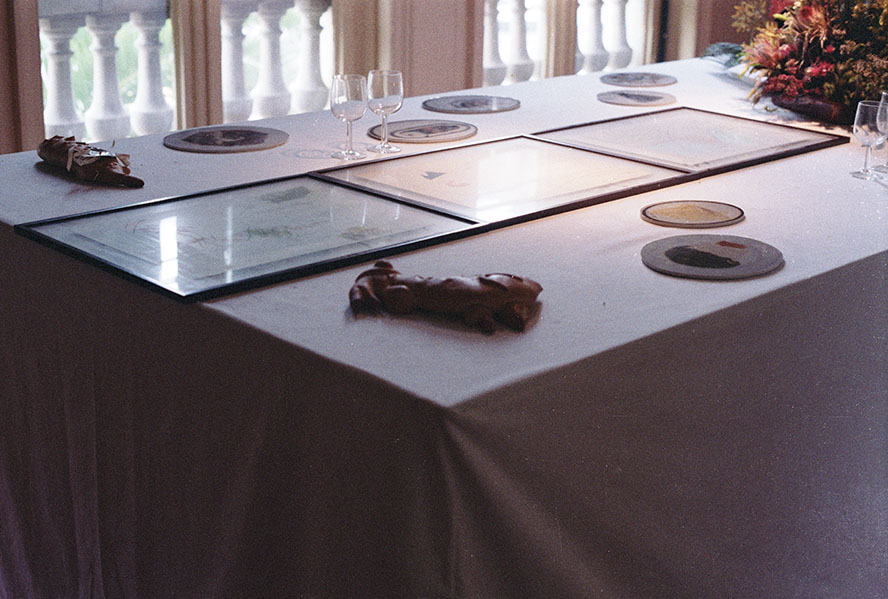
The sea is a festival
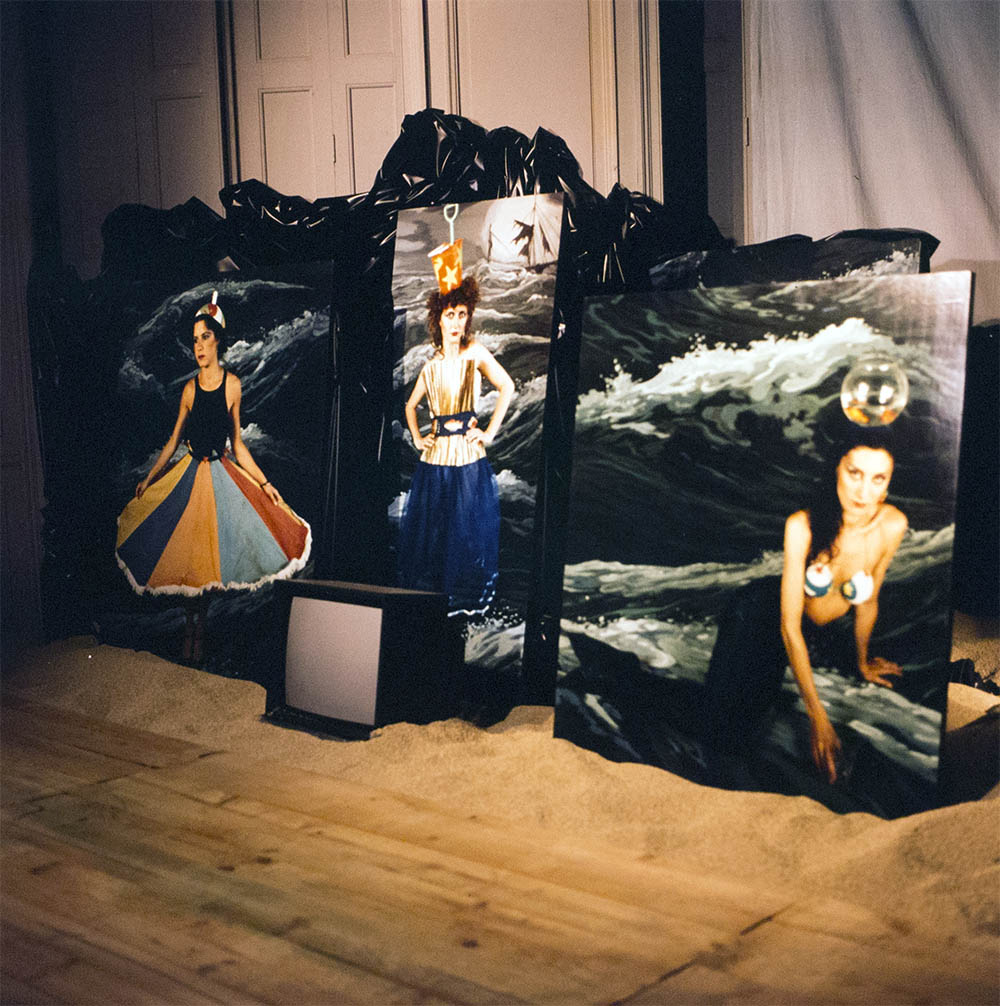
On an artificial beach created with fake sand and a sea of black plastic in a tribute to Federico Fellini, the space reinterpreted the 1979 Sea Festival carried out by the Set Design class taught by Xavier Olivé. It showcased life-size reproductions of the portraits that the photographer Colita made of the different characters that evoked real and imaginary marine animals.
Television monitors played videos made by Carles Ameller of the following performances:
- Imaginary animals (1985), in which actors in make-up and costumes depicting mythological animals were locked inside cages, as if they were circus sideshows.
- Pastoral: notes for a painting (1986). A giant golden frame encloses a section of the garden depicting a tableau vivant of an imaginary painting inspired by the work of painters such as Nicolas Poussin and Jean-Honoré Fragonard.
Related posts: The sea is a festival; Imaginary animals; The pastoral.
Un còmic en viu
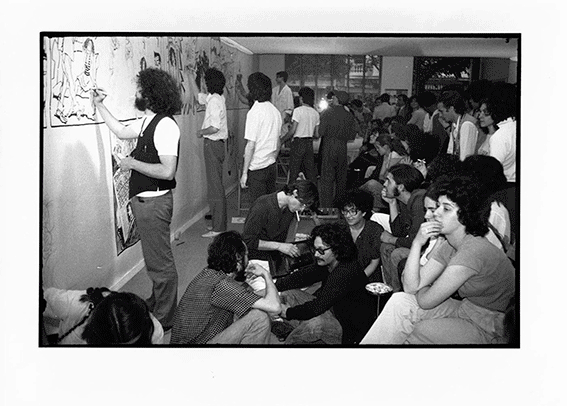
Evoking the eponymous action held in Gallery 13 in 1980 to celebrate EINA's 13th anniversary, a room was prepared with its four walls painted white and a black grid going from the floor to the ceiling. On the day of the inauguration, Enric Sió painted the first vignette live, as if it were a surreal "exquisite corpse". In the following days, each session involved a different artist continuing the story that was unfolding by adding new vignettes. Montesol, Peret, Outomuro, Roger, Mariscal, and Cesc also took part in the piece.
Realistic still life
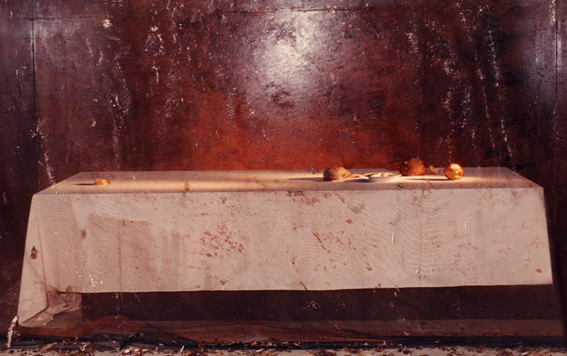
In this minimalist still life, attendees could see a white tablecloth, a partridge, an apple, bread, and a plate with an egg on the table. The tulle painted with pigments separated observers from nature. The ground littered with feathers evokes the result of having plucked the birds. The space was closed due to food rot.
Related post: Realistic still life.
A wall
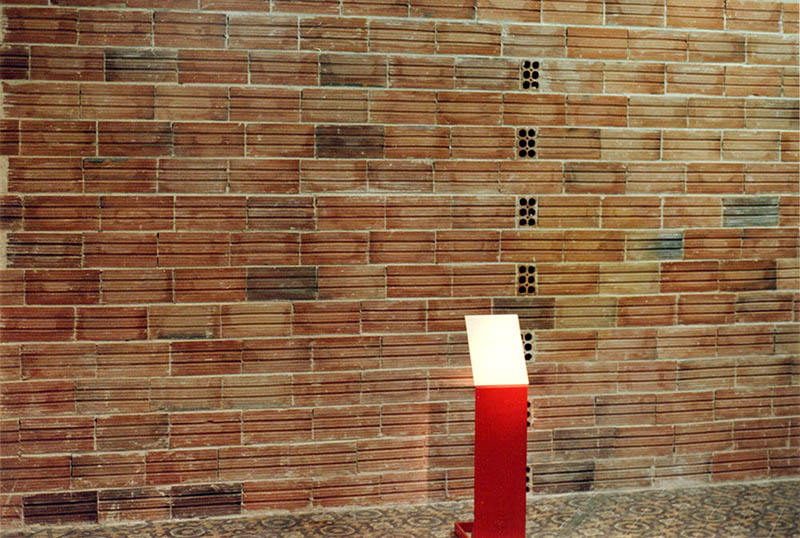
This space was designed by Dani Freixes and Pere Riera, who were asked to evoke some of their montages at EINA. It was an extremely conceptual piece as the space was covered and inaccessible, transformed by the artists into a recipient of memories where each visitor had to imagine what was behind the wall.
Graphic design
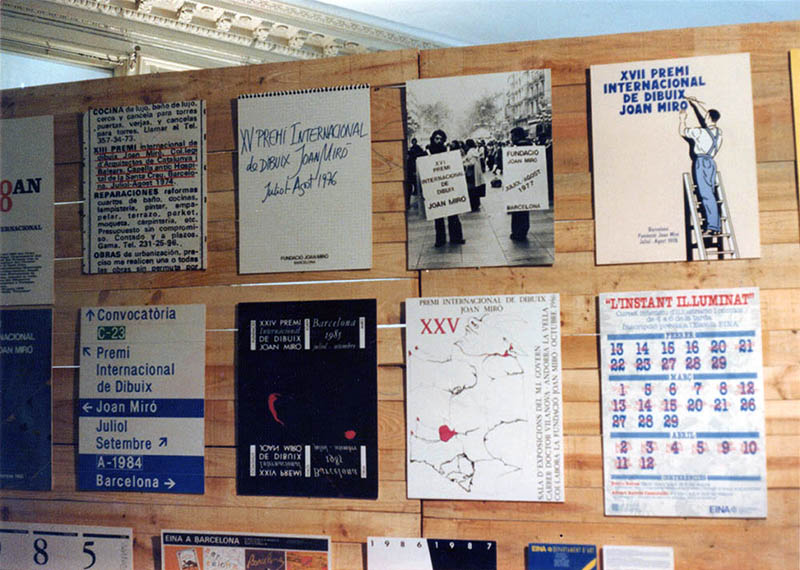
The space included a collection of posters designed by students that were submitted to the Joan Miró International Drawing Prize Poster Contest, not to mention other posters and graphic pieces designed at the School. At the time of the exhibition, Claret Serrahima and Josep M. Mir were the directors of the graphic design department at EINA. Prior to that, it had been America Sanchez, Toni Miserachs, and Joan Enric Lahosa (graphic and image).
EINA's new corporate image
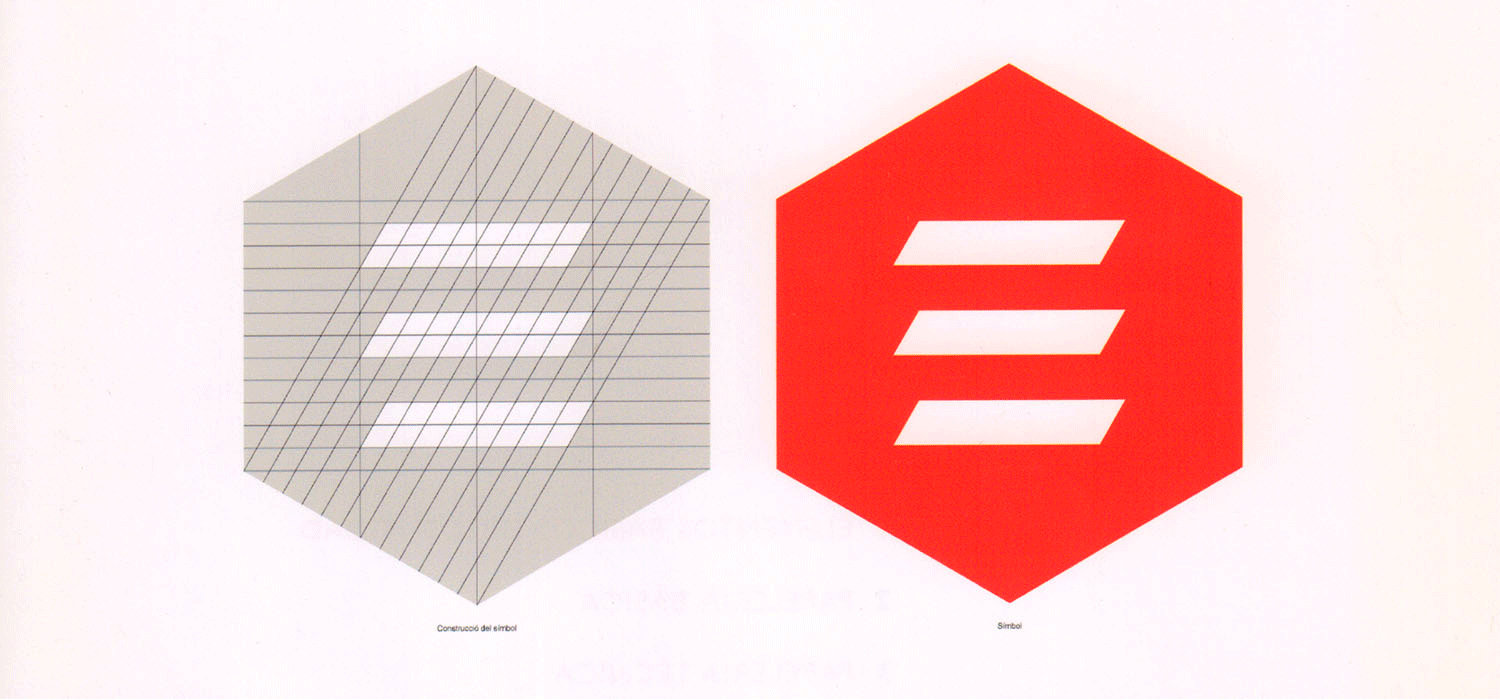
Coinciding with the celebration of EINA's twentieth anniversary, America Sanchez, who had previously designed EINA's corporate image in 1967, created a new graphic image for the school. The cube seen in perspective with three lines that formed the letter E, the lines of which symbolised EINA's three specialties (graphic design, interior design, and industrial design), are synthesised to be transformed into three white horizontal lines on a red hexagon, or the hexagonal section of a cube, depending on the perspective.
Showcases dedicated to industrial design
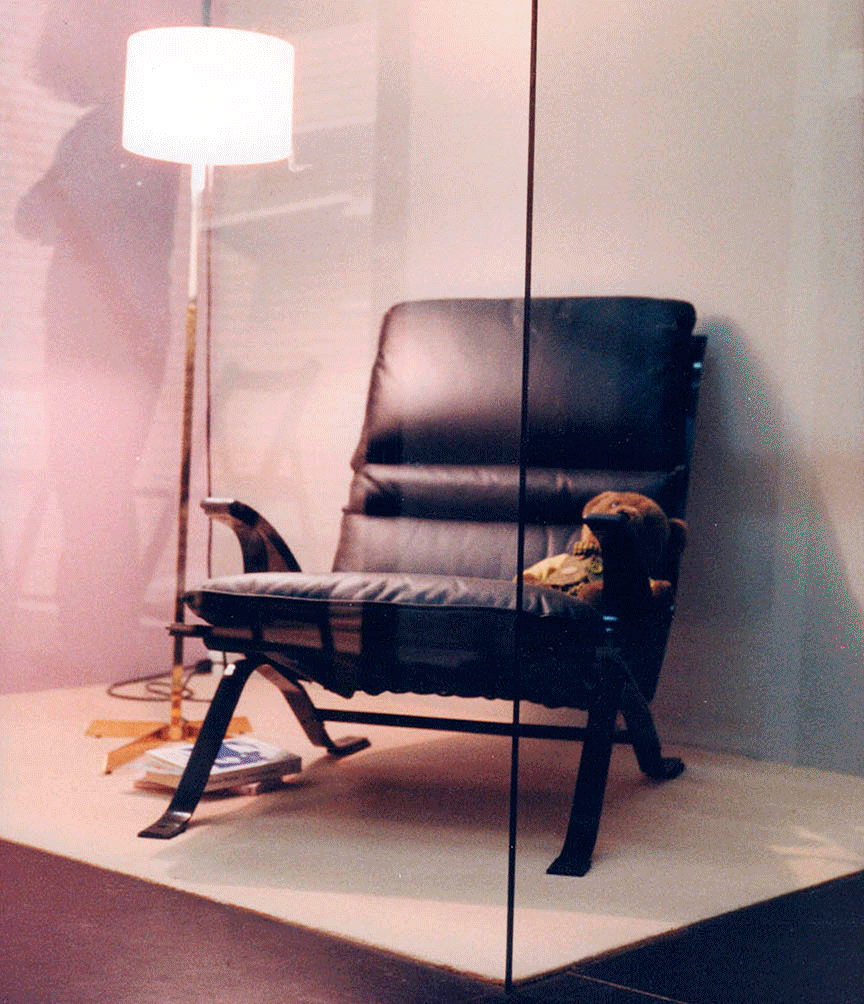
In this space, designed by Josep Aregall, the showcase windows of a commercial gallery dedicated to some of the most representative objects of the 70s and 80s, designed by EINA professors, were recreated: the Tramo shelf by Josep Antoni Blanc, the TMC by Miguel Milà, the Truman armchair by Josep Bonet, and lamps, a table by Jordi Garcés, and Bibelot Boreal by Carlos Pazos, an object that consisted of a reinterpretation of his own work Six memories, plus still lifes, in which the projection of these images was cut and manipulated by differently coloured neon tubes.
Inauguration
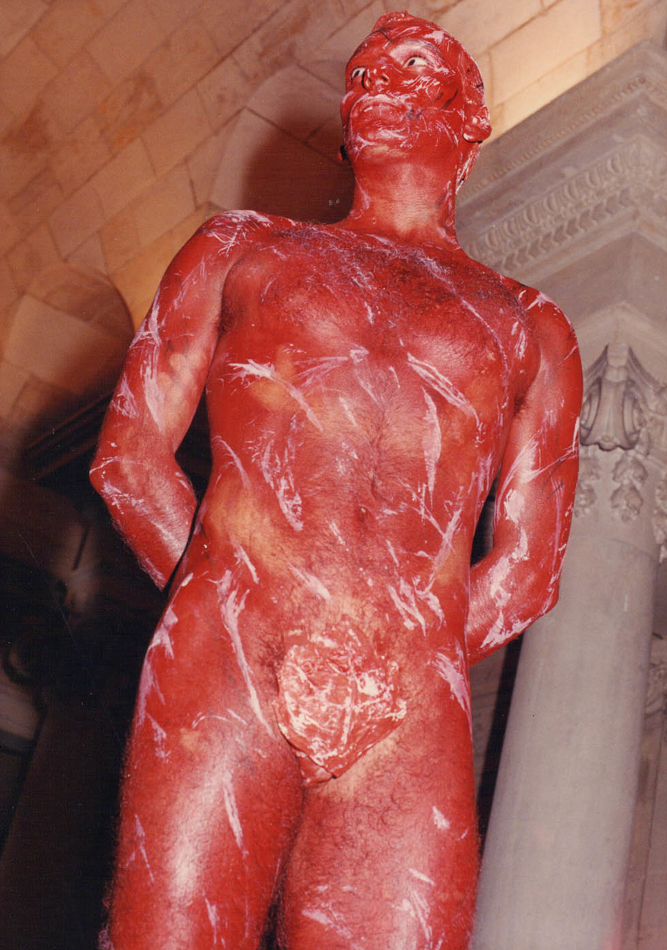
On the day of the inauguration, every space came to life. At the entrance to the exhibition, an actor doing classical sculpture recalled the performance Sculptures in the outdoors (1975).
In the kitchen space, Antoni Escribà drew up edible dedications for attendees and Maria Dolors Boadas, from the Boadas Cocktail Bar, offered the EINA cocktail created especially for the school. The Otto Zutz and Universal bars also participated, while Agustí Fernàndez performed his compositions on the piano.
Open design and art workshops
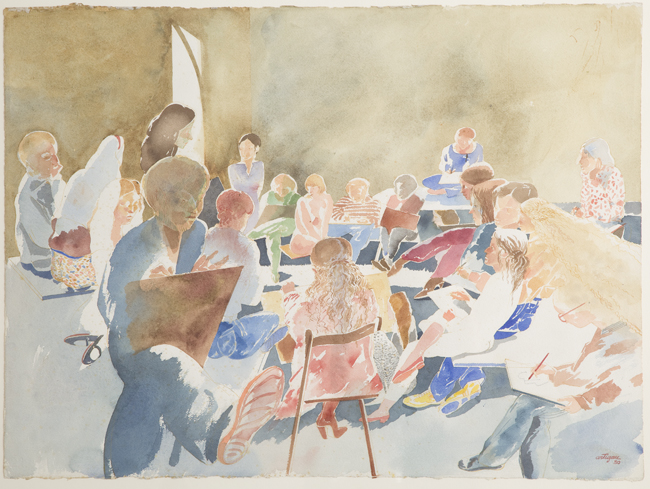
The wooden labyrinth running throughout the rooms of the Palau Robert transformed into the classroom stage where different activities and workshops were taught. In this space, Oriol Bohigas gave the inaugural lecture for academic year 1986/87, entitled Uglier than the Dump, in which Bohigas criticized the conversion of the building by the architect Francesco Sabatini to the Museo Nacional Centro de Arte Reina Sofía, or Sofidou, a name used to ridicule the alleged parallels with the Centre Pompidou in Paris. Bohigas, who had been working on the assembly of the first temporary exhibit at the museum, stated in his speech that the brightest moment in the building’s history was in 1969 when its demolition was proposed.
The inaugural classes in the Graphic Design, Interior Design, and Art Department were also taught in this space. Over the following days, painting, drawing, and engraving workshops were led by Francesc Artigau, Yamandú Canosa, Joaquim Chancho, Maria Girona Josep Guinovart, Joan Hernàndez Pijoan, Albert Ràfols Casamada, and Antònia Vilà; calligraphy workshops by Amanda and Keith Adams; art and poetry workshops by Vicenç Altaió; drafting workshops by Ramón Barnils; photography workshops by Manel Esclusa; and cooking workshops by Miquel Espinet, Joan Enric Lahosa, Llorenç Torrado, and Xavier Olivé. One example, in the Make-up Workshop led by Susana G. Körver and Joan Alonso and featuring participation by Marcel Perruqueria and Ramón Ramis for the costumes, was the live creation of Mermaid in a pan, as shown below.
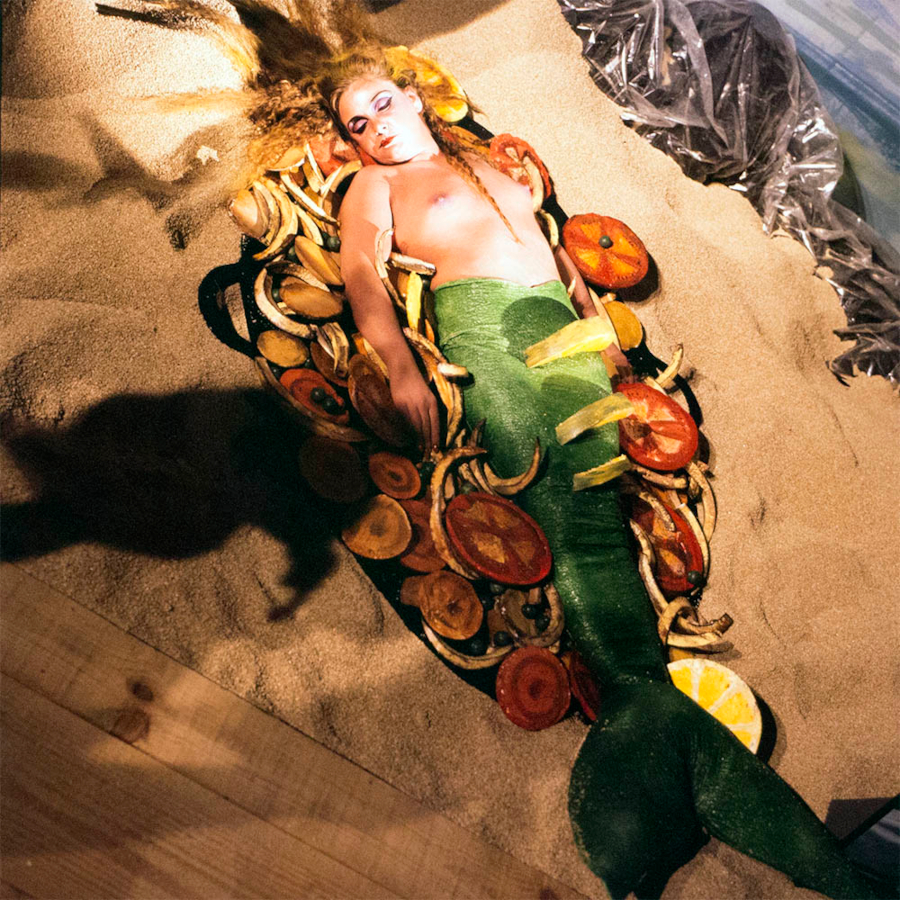
Cultural activities
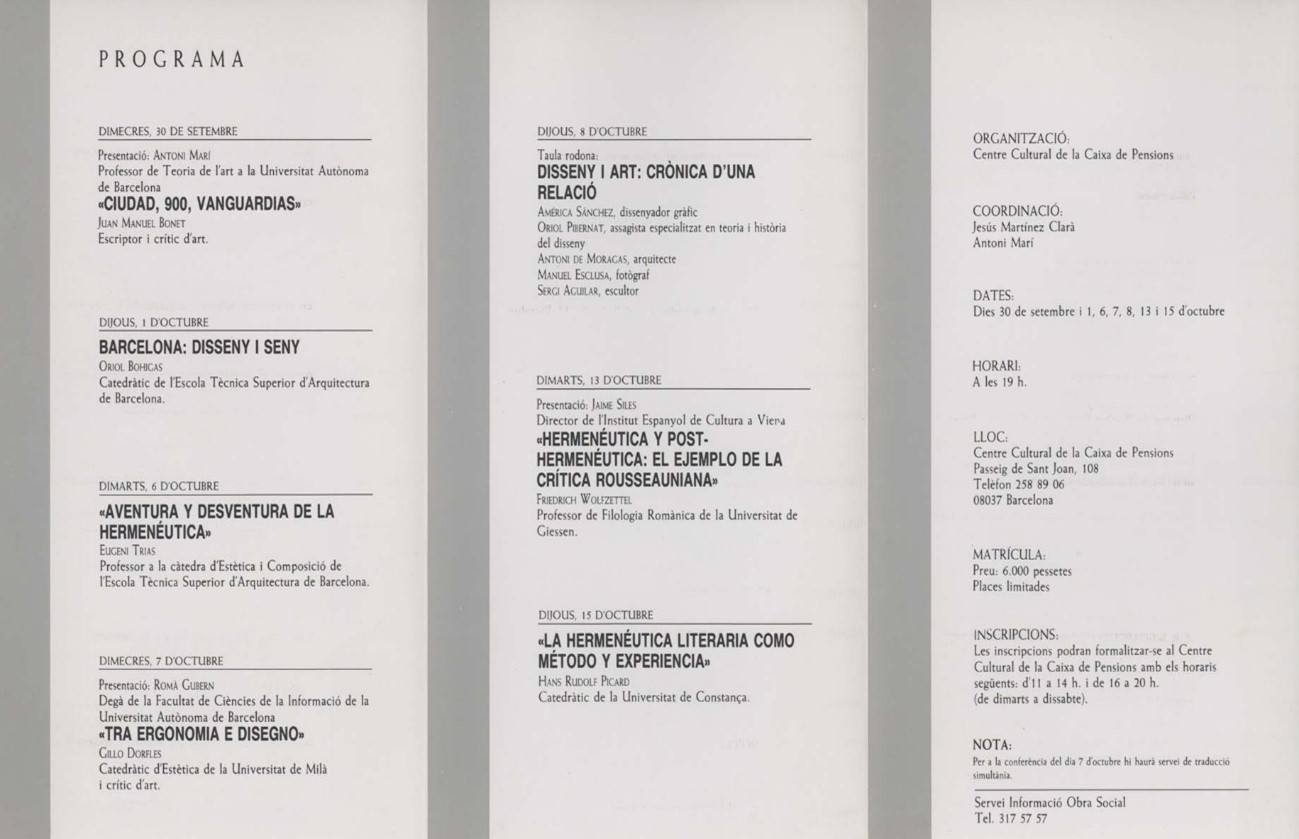
The cultural activities that took place as part of the anniversary were led by Toni Marí and Jesús Martínez-Clarà. Finally, the book/catalogue of the exhibition designed by Salvador Saura and Ramon Torrente and coordinated by Josep M. Villena produced as a result of the celebration is worth highlighting as it received an honourable mention at the seventh edition of the Catalan Literature Awards held by the Literary Institute of Catalonia in April 1988.
Credits
- Curation and design of the exposition: Beth Galí and Xavier Olivé with participation by Josep Aregall, Màrius Quintana, and Anna de Tort.
- Cultural activities: Toni Marí and Jesús Martínez-Clarà.
- Coordination of publications: Josep M. Villena.
- Curation of the anniversary: Toni Miserachs.
- Photography: Toni Mateu.
